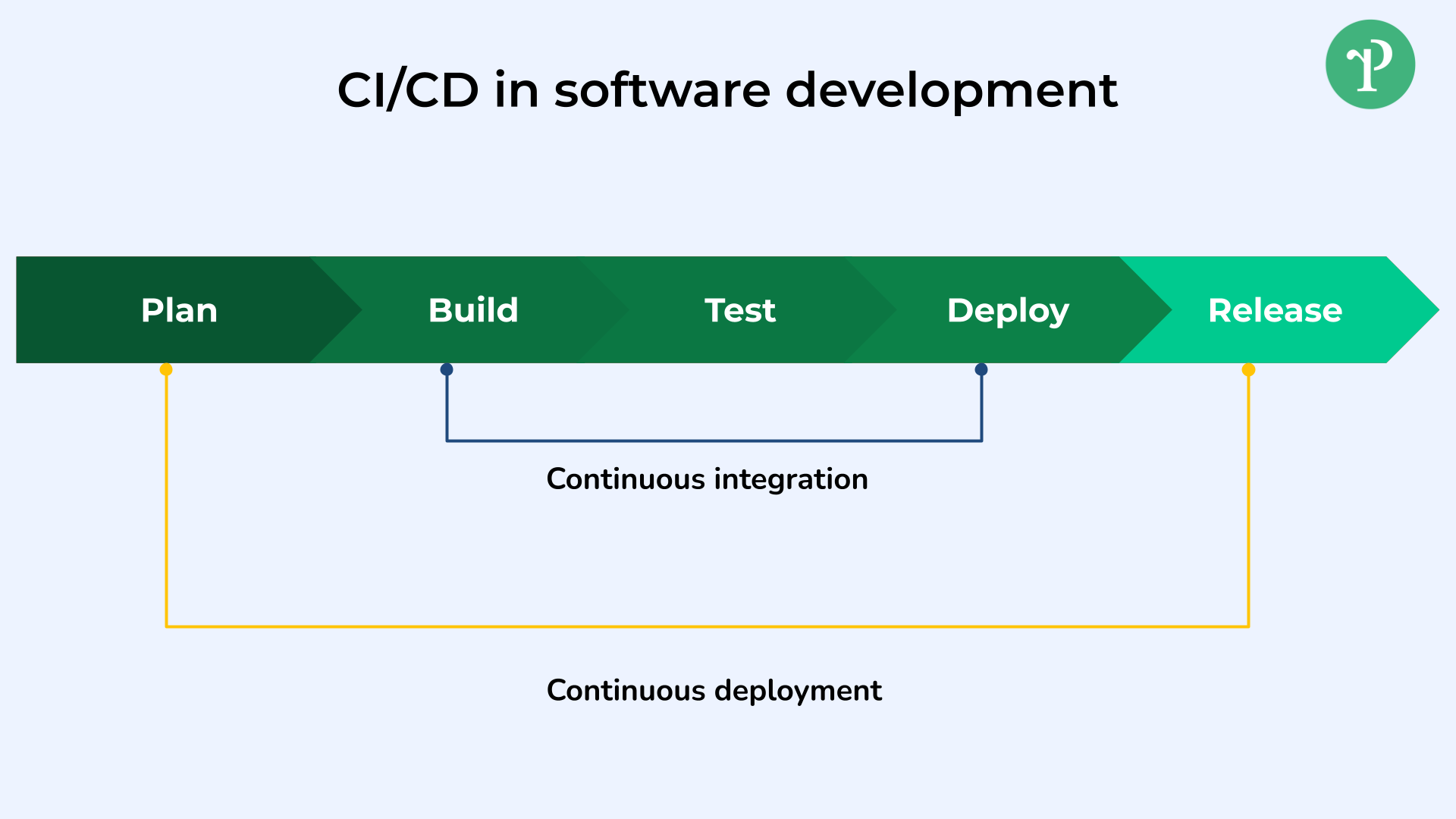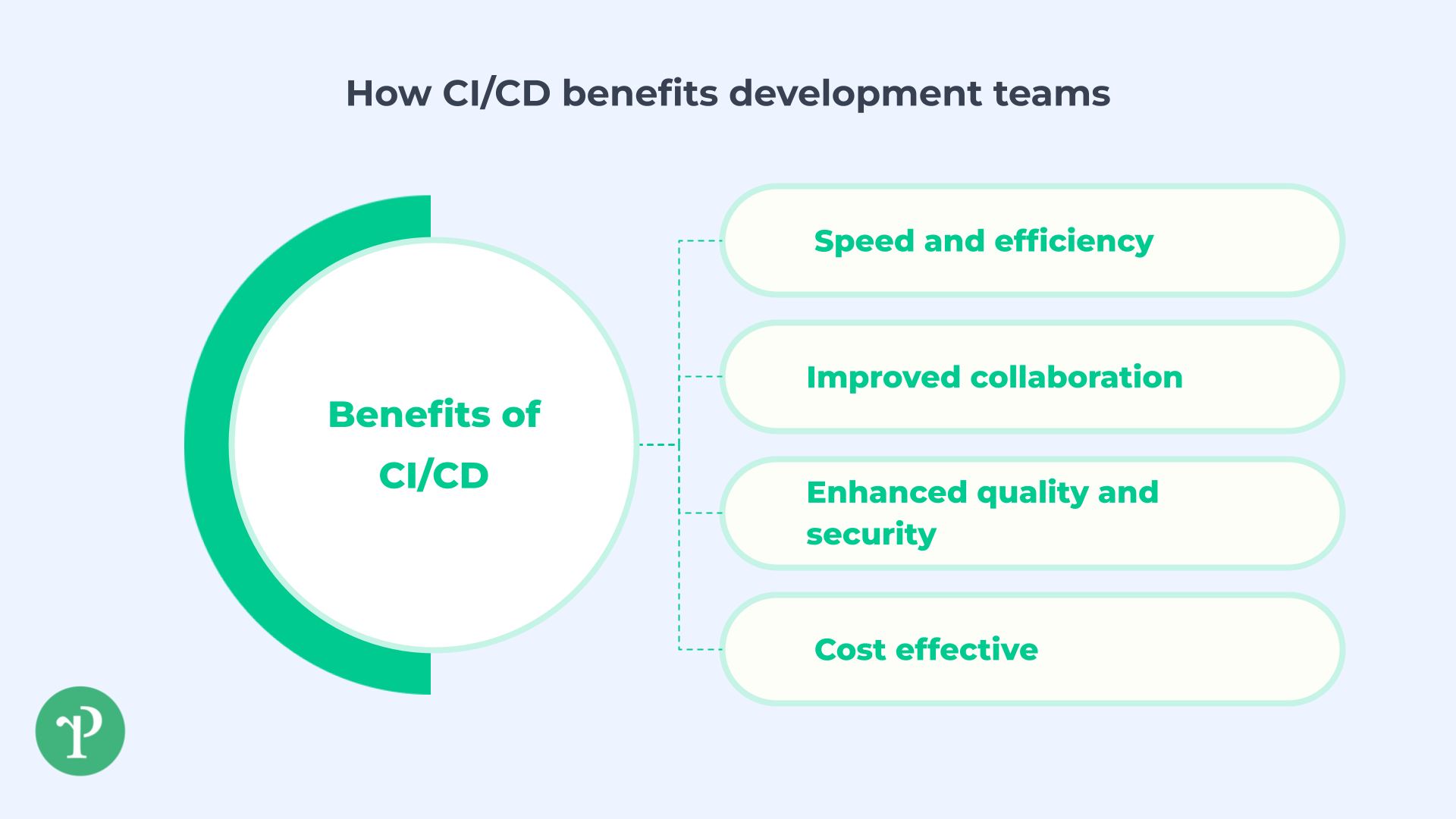Continuous Integration (CI) and Continuous Deployment (CD) are like the building blocks of today’s software making process. Think of CI as a team of people working together smoothly. As soon as one person makes a change, everyone knows about it and makes sure it fits well. CD, on the other hand, is like getting those changes out the door and into people’s hands without any fuss.
Together, CI and CD help make sure that when software is being made, everything goes smoothly, quickly, and without any major hiccups. Let’s dive into these ideas and explore what they mean and why they’re so important for anyone making software these days.
Continuous integration (CI)
Continuous integration is all about making regular, incremental code changes.
As multiple developers commit new code to the main branch of the project, the continuous integration process ensures that these changes don’t conflict with existing code.
Automated tests, including unit and integration tests, ensure that the code meets the required standards. Static code analysis further helps in maintaining code quality.

Continuous deployment (CD)
Continuous deployment (not to be confused with continuous delivery) takes the process a step further by moving code from the development stage to the live production environment.
Unlike continuous delivery, every change that passes through automated testing is deployed automatically, ensuring that new features, bug fixes, and changes are rolled out rapidly.
How CI/CD benefits development teams

Speed and efficiency
The CI/CD pipeline increases development velocity by enabling developers to work concurrently.
Automated builds and test automation allow developers to focus more on writing quality code and less on the logistics of moving code through the development process.
This means faster turnaround times for new features and less context switching, saving both time and effort.
Improved collaboration
Both development and operations teams can benefit from CI/CD as it bridges the gap between coding, testing, and deployment.
This collaboration ensures smoother workflows, consistent use of database scripts, and better alignment with cloud infrastructure.
Enhanced quality and security
Software quality is paramount, and CI/CD brings in a level of rigor with continuous testing, integration tests, and regression tests.
Regular security testing ensures that the application is robust against potential threats.
Cost-effective
With automated processes like the CI/CD pipeline, human effort is greatly reduced.
Features like packaging and shipping applications and automated deployment to production environments save both time and costs.
Why your business should adopt CI/CD
1. Adapting to market changes: The agility provided by CI/CD allows businesses to respond to market demands quickly, whether it’s implementing new features or adapting to new regulations.
2. Satisfying customer needs: By speeding up the development lifecycle, businesses can provide updates, new features, and fixes to customers more frequently, leading to higher satisfaction.
3. Ensuring compliance and transparency: The structured process within CI/CD ensures that the necessary compliance standards are met. It also improves transparency in the development life cycle.
4. Strategic focus on core business goals: CI/CD frees up resources, allowing organizations to focus on strategic business requirements like innovation and growth.
Professionals needed to implement CI/CD automation
Implementing CI/CD automation is not a solitary effort but a collaborative endeavor that requires a combination of skill sets. Here’s a list of key professionals and their roles in implementing CI/CD automation:
1. DevOps engineers
DevOps engineers play a vital role in bridging the gap between development and operations teams. They work on automating and optimizing the CI/CD pipeline, ensuring a seamless transition from development to deployment.
2. Software developers
Software developers are the core of the CI/CD process, pushing new code, fixing bugs, and working on new features. They collaborate closely with other team members to ensure that the code meets quality standards through continuous integration and testing.
3. QA (Quality assurance) engineers
QA engineers focus on maintaining software quality throughout the development lifecycle. They create, manage, and execute automated tests, including unit tests, integration tests, and regression tests, as part of the continuous testing process.
4. Security professionals
Security professionals are responsible for ensuring that the software is secure and free from vulnerabilities. They conduct regular security testing, work closely with developers to address potential security issues, and ensure compliance with security standards.
5. System administrators
System administrators manage the underlying infrastructure that supports the CI/CD process. They ensure that the servers, databases, and other essential components are properly configured and maintained. Their role includes managing cloud infrastructure and handling the deployment process.
6. Project managers and scrum masters
These professionals ensure that the CI/CD process aligns with the overall project goals and timelines. They facilitate collaboration among various teams and stakeholders and keep the project on track by coordinating tasks and managing resources.
7. Database administrators
Database administrators (DBAs) handle the database scripts, schema changes, and other database-related tasks within the CI/CD process. They work closely with developers and system administrators to ensure that the database is in sync with the application’s requirements.
8. Product owners and business analysts
Product owners and business analysts work to align the CI/CD process with the business requirements and customer needs. They provide the vision and direction for the project, translating business goals into actionable tasks for the development teams.
Conclusion
CI/CD automation isn’t just a trend; it’s a vital part of contemporary software delivery processes. It’s about making software development simpler, easier, and faster for everyone involved, from the developers who push code to the operations team that manages production environments. By prioritizing collaboration, quality, efficiency, and alignment with business needs, CI/CD serves as a critical tool to meet today’s ever-changing business landscape.












